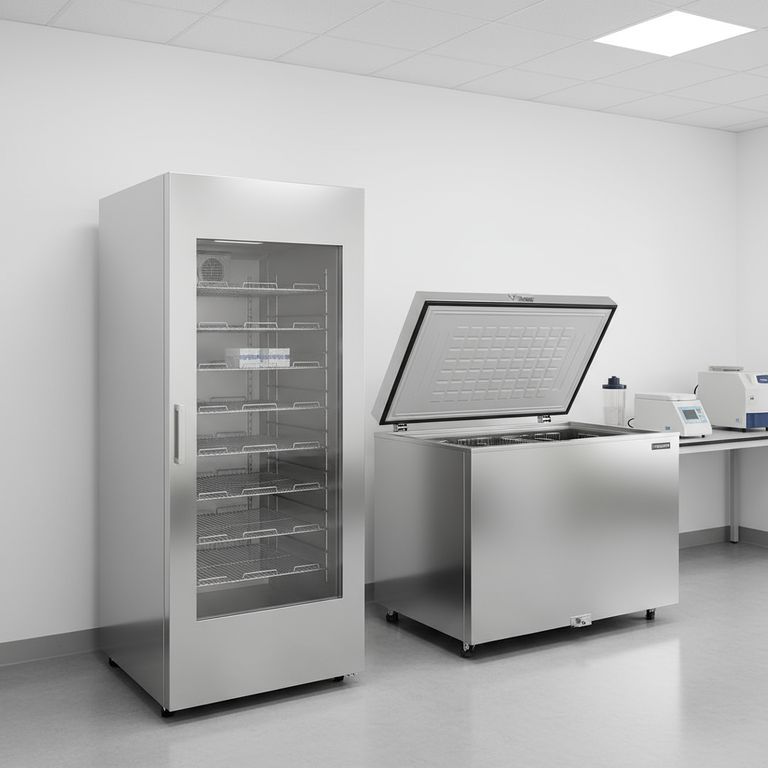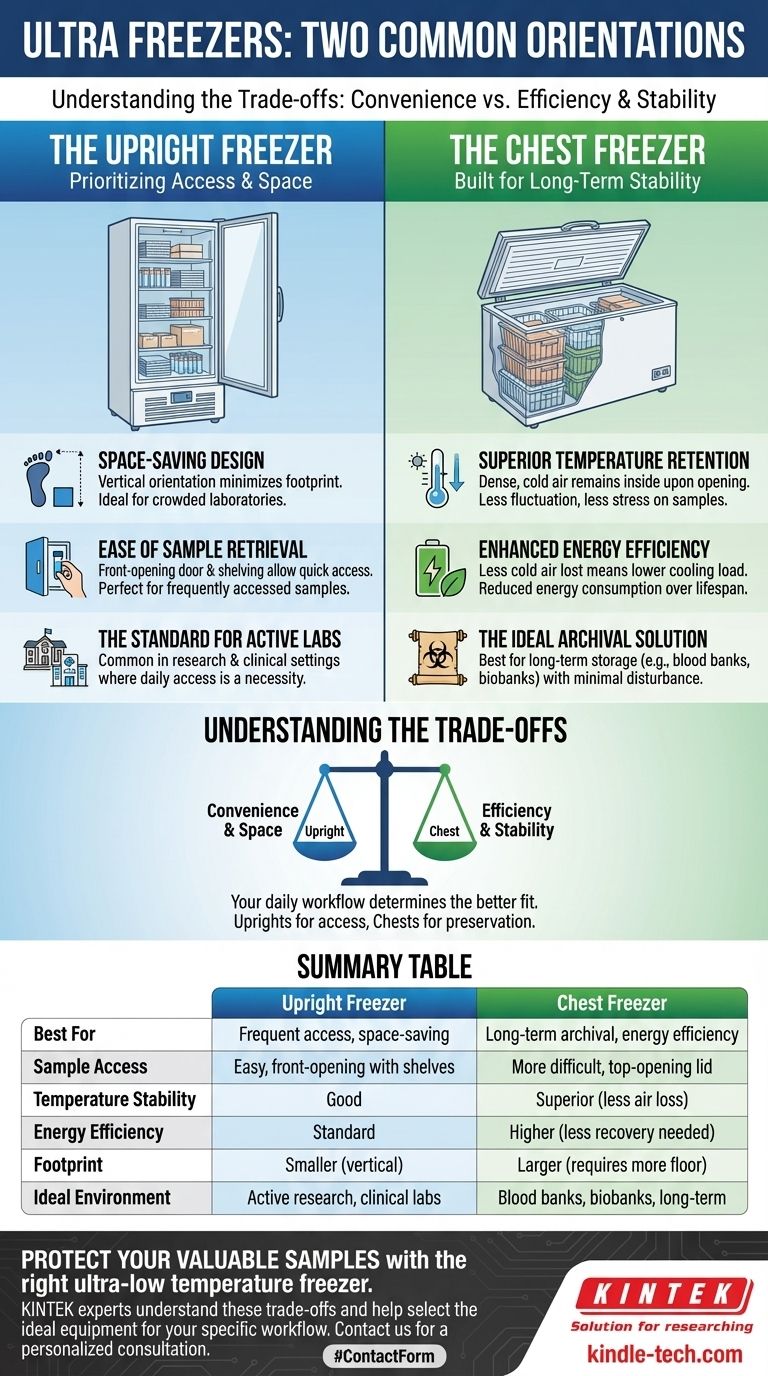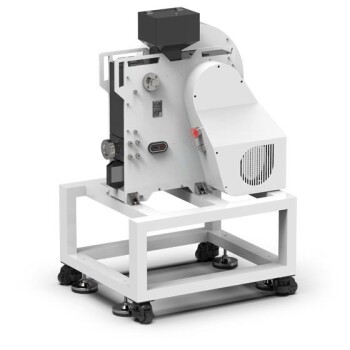The two common orientations for ultra-low temperature (ULT) freezers are the upright freezer and the chest freezer. The upright model, resembling a standard refrigerator, is the more common choice in laboratory settings as it saves valuable floor space and allows for easier organization and access to samples.
The decision between an upright and a chest freezer is a fundamental trade-off. You are choosing between the immediate convenience and space-saving design of an upright model versus the superior temperature stability and energy efficiency of a chest model.

The Upright Freezer: Prioritizing Access
Upright ULT freezers are the default choice for many labs because their design is optimized for the dynamic workflow of active research and clinical environments.
Space-Saving Design
The vertical orientation of an upright freezer minimizes its footprint. This is a critical advantage in crowded laboratories where floor space is at a premium.
Ease of Sample Retrieval
With a front-opening door and internal shelving, upright models allow users to quickly locate and retrieve specific samples. This makes them ideal for materials that are accessed frequently.
The Standard for Active Labs
Due to their convenience and efficient use of space, upright freezers are commonly found in research universities, hospitals, and biotech labs where daily access to samples is a necessity.
The Chest Freezer: Built for Long-Term Stability
Chest freezers, which open from the top, are engineered for a different purpose: maximum efficiency and the secure, long-term preservation of samples that are not needed often.
Superior Temperature Retention
When you open a chest freezer, the dense, cold air tends to remain inside the insulated chamber. This simple principle of physics means less temperature fluctuation and less stress on the stored samples.
Enhanced Energy Efficiency
Because less cold air is lost upon opening, the freezer's cooling system does not have to work as hard to return to its setpoint. This results in lower energy consumption over the freezer's lifespan.
The Ideal Archival Solution
The chest freezer's stability makes it perfectly suited for long-term archival storage. This is common in blood banks, forensic labs, and for biological repositories where samples must be preserved for years with minimal disturbance.
Understanding the Trade-offs
Choosing the correct freezer orientation requires a clear understanding of the compromises involved with each design. Your daily workflow and storage goals will determine which is the better fit.
Convenience vs. Efficiency
The core trade-off is straightforward. Upright freezers offer superior convenience for finding and retrieving items. Chest freezers offer superior energy efficiency and temperature stability.
Footprint vs. Organization
While uprights save floor space, chest freezers are bulkier and require more room. Furthermore, organizing and accessing samples at the bottom of a deep chest freezer can be challenging.
Cost Considerations
The choice also depends on your budget. You must weigh the initial purchase price against the long-term operational costs, where the chest freezer's higher energy efficiency can offer savings over time.
Making the Right Choice for Your Application
Your final decision should be guided by the primary purpose of the freezer within your specific environment.
- If your primary focus is frequent sample access and saving floor space: The upright freezer is the standard choice for an active laboratory environment.
- If your primary focus is long-term archival storage and energy efficiency: The chest freezer provides superior temperature stability and lower operating costs for preserving samples over extended periods.
Ultimately, selecting the correct freezer orientation ensures your valuable samples are protected in a way that best supports your scientific goals.
Summary Table:
| Feature | Upright Freezer | Chest Freezer |
|---|---|---|
| Best For | Frequent sample access, space-saving | Long-term archival storage, energy efficiency |
| Sample Access | Easy, front-opening door with shelves | More difficult, top-opening lid |
| Temperature Stability | Good | Superior (less cold air loss) |
| Energy Efficiency | Standard | Higher (less energy to recover temperature) |
| Footprint | Smaller (vertical design) | Larger (requires more floor space) |
| Ideal Environment | Active research, clinical labs | Blood banks, biobanks, long-term storage |
Protect your valuable samples with the right ultra-low temperature freezer.
Choosing between an upright and chest model is a critical decision for your laboratory's efficiency and sample integrity. The experts at KINTEK understand these trade-offs and can help you select the ideal equipment for your specific workflow and storage requirements.
We specialize in providing reliable lab equipment and consumables, ensuring you have the right tools for your research. Contact us today for a personalized consultation and discover how we can support your laboratory's success.
Visual Guide

Related Products
- 808L Precision Laboratory Vertical Ultra Low Temperature Freezer
- 308L Precision Ultra Low Temperature Freezer for Laboratory Applications
- 158L Precision Vertical Ultra Low Freezer for Laboratory Applications
- 208L Advanced Precision Laboratory Ultra Low Temperature Freezer for Cold Storage
- 608L Essential Laboratory Ultra Low Temperature Freezer For Critical Sample Preservation
People Also Ask
- What makes Ultra-Low Temperature freezers energy efficient? Key Design & Operational Strategies
- What is an ultra-low temperature freezer? Protect Your Most Valuable Biological Samples
- Where are ultra low temperature freezers commonly used? Essential for Labs, Hospitals, and Biotech
- What are the key construction features of ultra low temperature freezers? Essential Design for Protecting Critical Samples
- In what fields are ultra low temperature freezers most commonly used? Essential for Biomedical, Clinical, and Research Labs



















